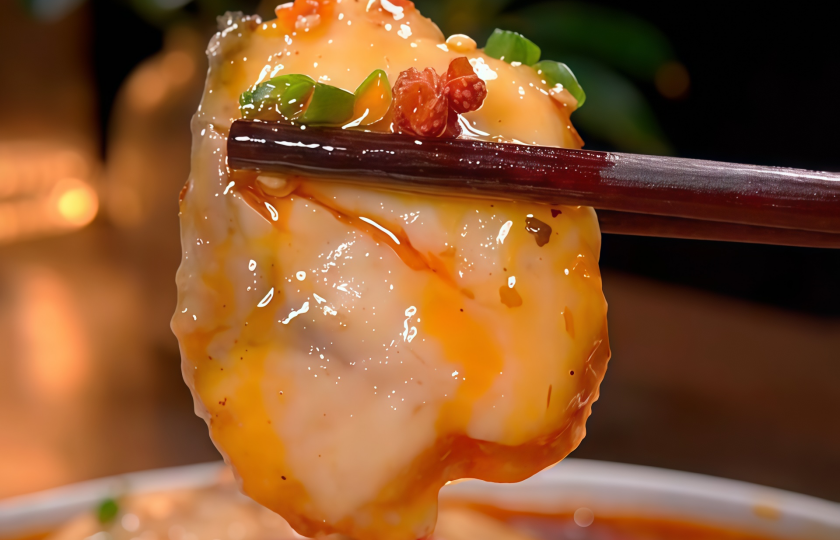Sichuan Boiled Fish: Easy Instructions

Among Sichuan dishes, boiled fish stands out with its unique cooking method and unforgettable taste. Let's learn every crucial step of this classic delicacy together.
What is Sichuan boiled fish?
"Boiled fish" may sound plain and fails to capture the essence of this dish at all. This dish might be the exact opposite of what you imagine "boiling" to be. Sichuan boiled fish is a spicy and numbing signature dish that people love and fear at the same time. Its essence lies in the moment when the hot oil stimulates the aroma.
It looks completely red, but actually the spiciness level can be adjusted. The key is to use half the amount of chili peppers when stir - frying the base ingredients and scoop out some of the Chinese prickly ash before pouring the hot oil at the end.
The recipe I use here involves hot pot base ingredients, which is very suitable for a homemade version as it eliminates a lot of complicated procedures. The traditional way involves stir - frying broad bean paste and pounded chili peppers by oneself.
For side dishes, bean sprouts and soft tofu are recommended. They soak up the soup well without overpowering the main flavor.
What are the characteristics of this dish?
A fierce spicy and numbing taste impact: The double spiciness of the hot pot base and freshly poured hot oil, the numbing sensation of the Chinese prickly ash spreads from the tip of the tongue to the ears. It's just right when your lips are slightly trembling after eating.
The fish slices are so tender that they're hard to pick up with chopsticks: Coating the fish slices with egg white and starch creates a protective layer. Slide the fish slices into the water when it's almost boiling but not quite there yet. Treat them gently, just like cooking wontons, and they'll be cooked just right without any blood streaks.
Rich in oil but not greasy: Although there seems to be a layer of red oil floating on top, the soup at the bottom can actually be drunk. The secret lies in stir - frying the spices thoroughly to extract a spicy and fragrant base flavor without being overly drying. It's actually appetizing when served with rice.
Visually fiery and attractive: With a base of red oil, the white fish slices are faintly visible. The puff of hot air when pouring the hot oil at the end gives the dish an imposing presence when it's served on the table.

What kind of fish should be used?
Many types of white fish can be used for this dish, but personally, I prefer fish with a slightly higher oil content, as this results in a more satisfying taste. In China, I particularly like to order catfish because it is affordable and has delicious meat.
However, it can be difficult to find small - sized catfish in some places. I ended up using perch and was very satisfied with the result. Alternatively, you can also use perch, bream, flounder, and other white fish, as long as their meat is firm.
Remember not to use cod, because it will fall apart during the cooking process.
How long does it take to cook the fish in this recipe?
It only takes 1 minute to actually cook the fish slices.
Cooking timing: Keep the soup at a gentle simmer (small bubbles form at the edges). At this time, the water temperature is about 85 - 90°C, which is the most suitable for gently cooking the fish slices.
Actual cooking: After putting the fish slices into the pot, gently spread them out with chopsticks and maintain a gentle boil over medium heat. From the time they are put in the pot until they are taken out:
Thin fish slices (2mm): 20 - 30 seconds
Slightly thicker slices (3 - 4mm): 40 - 50 seconds
Determining doneness: When the fish changes from transparent to completely white and the edges curl slightly, turn off the heat immediately. The afterheat will continue to cook the fish, and if you take it out too slowly, it will become tough.
INGREDIENTS
Main Ingredients
-
·300g fish slices
Additional Ingredients
-
·Appropriate amount of side dishes (such as bean sprouts, tofu skin, greens, etc., according to personal preference)
-
·2 cloves of garlic (minced)
-
·1 spring onion (chopped)
-
·5g of sesame seeds
-
·Appropriate amount of dried chili peppers and Chinese prickly ash (adjust according to taste)
Seasonings
-
·3g salt
-
·3g pepper powder
-
·1 tablespoon of cornstarch
-
·1 egg white
-
·10ml dark soy sauce
-
·5g chicken essence
-
·Appropriate amount of cooking oil (for stir - frying to bring out the flavor and pouring hot oil)
-
·1 piece of hot pot base
COOKING STEP
Step 1
Add 3g of salt, 3g of pepper powder and scallion - ginger water to the fish slices. Knead until sticky.

Step 2
Then add 1 egg white and 1 tablespoon of starch. Mix well and marinate for 10 minutes.

Step 3
Pour an appropriate amount of oil into a hot pot. Add scallions, ginger, garlic, dried chili peppers, Chinese prickly ash and 1 piece of hot pot base. Stir - fry until fragrant.

Step 4
Pour in an appropriate amount of clear water. Add 3g of salt, 5g of chicken essence and a little dark soy sauce.

Step 5
After bringing to a boil, add your favorite side dishes. Once cooked, remove them and place them at the bottom of a bowl.

Step 6
When the water is slightly boiling, add the fish slices and gently spread them out. Once the fish changes color, remove it.

Step 7
Sprinkle with minced garlic, chopped scallions, dried chili peppers, Chinese prickly ash and some sesame seeds.

Step 8
Pour 1 tablespoon of hot oil over to stimulate the aroma, and then it's ready to be served and enjoyed!

More recipes worth trying
Deliciously Nourishing Classic Choice: Fish Head Tofu Soup
Secrets to Success
Keys to smooth and tender fish
When marinating the fish slices, knead them as if you're giving a massage until they become sticky. When you can feel a gelatinous texture on the surface of the fish, then coat them with egg white and starch. This step creates a protective layer for the fish slices, preventing them from becoming dry and tough during cooking.
Precise timing for pouring hot oil
After sprinkling the chili peppers and Chinese prickly ash, heat the oil immediately. There's a simple way to test the oil temperature: when you insert a wooden chopstick into the oil and fine bubbles form around it, the temperature is right. When pouring the hot oil, pour it from a height of 20 centimeters above the pot to ensure that the hot oil evenly drenches all the seasonings.
Controlling the taste of the soup base
Don't use too much hot pot base; half a piece is sufficient. First, stir - fry the base over low heat until it melts. Add water after you can smell the aroma of beef tallow. When tasting the soup, it should be a bit saltier than normal because the fish slices and side dishes will absorb the flavor.
Controlling the water temperature when cooking fish slices
When the water is almost boiling but not quite, turn the heat to the lowest setting. When the surface of the water is calm but small bubbles are rising from the bottom, add the fish slices. Use the back of a ladle to gently push the slices instead of stirring. Turn off the heat immediately when the edges of the slices start to curl after about 30 seconds.
Flexible adjustment of spiciness
For those who are not good at handling spiciness, use Erjingtiao dried chili peppers. For those who love extremely spicy food, switch to millet peppers. Before pouring the hot oil at the end, shake off some of the chili seeds to reduce the spiciness while retaining the aroma. Once, I replaced them with lantern peppers, which not only had a stronger aroma but also didn't irritate the throat.
Kitchenware usage tips
Using an iron ladle to pour hot oil is safer than pouring directly from the pot, and it also allows you to control the amount of oil. It's best to pre - heat the serving bowl in the oven. The heat - preservation effect can make the aroma last longer.
How to Eat Sichuan Boiled Fish
When eating Sichuan boiled fish, it's important to balance spiciness relief and the ultimate indulgence. Here are some common pairing ideas I often use:
Preferred staple foods for soaking up flavors:
Steam the rice a bit firmer in advance. Pour two spoonfuls of the red soup over it and mix well.
Cook handmade wide noodles until done, then rinse them with cold water. Place them at the bottom of a bowl and eat them as spicy fish soup noodles.
Three must - haves for relieving spiciness:
Chilled plum soup, cold - dressed wood ear mushrooms, and stir - fried pea shoots. The sour taste and refreshing sensation can buffer the spiciness and prevent the burning feeling in the stomach.
Techniques for scooping fish:
Use a ladle to scoop up the fish slices first, then use a soup spoon to pick up the side dishes and the red soup. Using chopsticks directly to pick up the fish slices can easily break them, and broken chili peppers in the soup may also mix in.
Staged eating methods:
In the first round, eat the fish slices in their original flavor to experience the smoothness and tenderness. In the second round, soak the bean sprouts and asparagus lettuce in the soup and eat them with rice. Finally, add white vinegar to the remaining soup base to make it sour and spicy, and cook vermicelli to soak up the flavor.
If you're hosting guests and worried that they may find it too oily, prepare a bowl of hot water beside for them to rinse the fish slices.
FAQs:
2.Turn to low heat when the water boils and cook slowly.
3.Gently spread out the fish slices when putting them into the pot; don't stir vigorously.
4.As soon as the fish changes color, take it out immediately; don't overcook it.

















